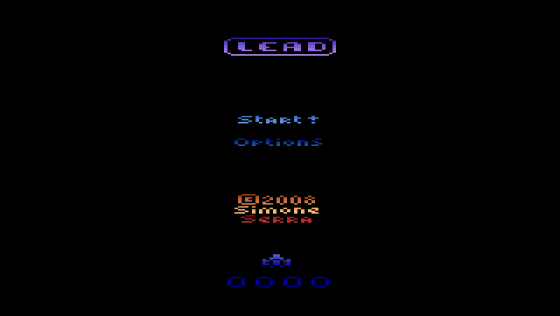
RGCD
 1st March 2009
1st March 2009
Categories: Review: Software
Author: Ruari O'Toole
Publisher: Simone Serra
Machine: Atari 2600
Published in RGCD #5
It received a glowing preview in issue #03, but has the final version of Lead 8K met our high expectations? Ruari gives the low-down.
Lead 8K
The phrase "fast and furious" has become a cliché and is bandied around far too much to have real meaning any more, but in the case of Lead the cliché rings true on more than one level. Weighing in at a paltry 8 kilobytes, Simone Serra's latest release for the Atari 2600 is impressively fast, and often makes for furious gameplay, but the great speed means that Lead can be more than a little infuriating to the novice player.
Even set on "normal" speed you can literally lose the game by blinking, and although "fast" speed is mercifully slower than I expected Lead still tests your reflexes to destruction. An earlier development version of the game had a "zzap" speed setting, which must have been terrifying. But don't get me wrong, this isn't a bad game, and you're not reading a hatchet-job review slamming a game just for being difficult. Quite the contrary, since Lead is one of the most impressive games I've seen this year and is ridiculously inventive and varied in spite of its tiny, tiny size.
Lead doesn't mess about and you're thrown into the action within seconds of your first button press. The first level is a quick and dirty vertical shoot-em-up where Space Invader look-alikes fly down at your nippy little craft, dressed in colours that are surely too rich for such a featherweight game. The shades of blue that make up your ship are great eye-candy, and the flashing boundary lines pulse happily as you laser the alien (I assume) hordes to bits.

Level two changes the record, and instead of an identical run with more and faster baddies you're taxed with a top-down, sci-fi version of Night Driver. Those happy, pulsing boundary lines still pulse happily but this time they swerve and slide, marking out a road for you (in true Night Driver style) to avoid obstacles on.
It's back to shooting on the third level, with the sweeping and swerving action introduced in the preceding level carrying over to make things tougher, and the whole thing is just so much unashamed fun. The first time the curves of the road conspired to line up five or six enemies for a fish-in-a-barrel laser wipeout I confess to punching the air, just a little bit.
Scramble! says the little introductory text that flashes up before level four, and it's a breakneck rush through a thick field of flying saucers. It's worth saving up those smart bombs that drop down on you now and then for this frantic stage, which makes the Death Star trench run look dull.
And after this? Why ruin the fun? The great thing about Lead is that it continues to surprise and challenge the player, and I'm not about the let the electric cat out of the bag and spoil stuff for you. I've already said too much as it is. As if it wasn't enough for Lead to deliver great gameplay and impressive graphics, the music is seriously impressive as well. It pushes the 2600's sound capabilities to the limits and dovetails neatly with the atmosphere and style of the game.
Lead. Phew.




